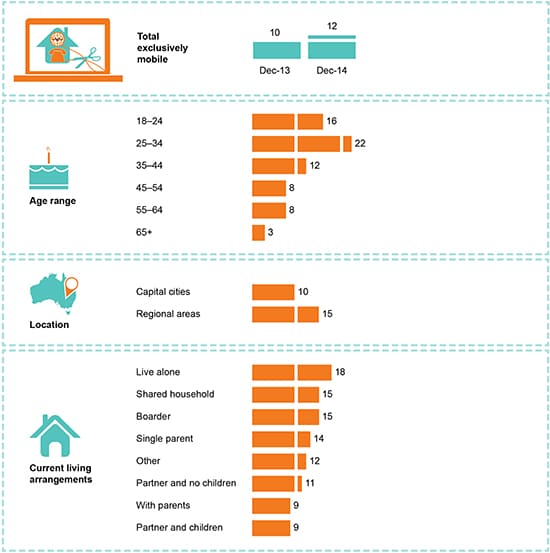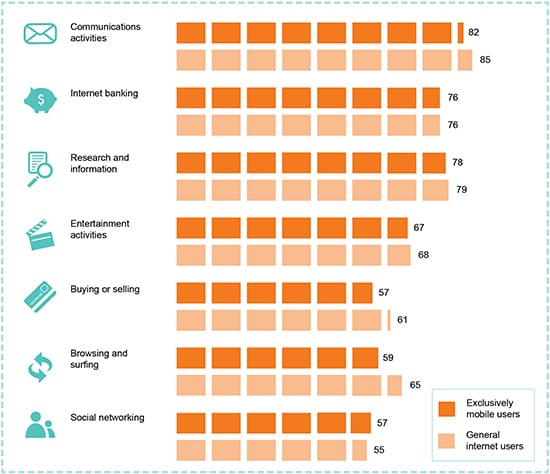Australian Communication and Media Authority (ACMA) published survey data that gave some fascinating insights into the changing face of telecommunication in Australia. 31%, which is 5.78 million Australians, don’t have a fixed landline at home. A 2009 report showed that 9 in 10 households had a fixed line phone, but today this number has dropped down to just 4. The past decade has seen a revolution in the phone industry, and consumers now have more choice, more purchasing power and more interaction with their digital lives. The reasons why more Australians are going mobile-only may seem obvious, but the fall out is considerably less so.
Mobile Only Change Drivers

- Age – As younger generations grow up, smartphones become the norm rather than the exception. People in the age group of 25-34 are twice as likely as the rest of the population to go mobile only. To them the phone is no longer about making calls, and the landline is only a relic of the past.
- Immigration – Australia’s Immigration boom has led to the arrival of a new wave of population that does not quite have a permanent residence. They haven’t purchased a home and may switch houses several times as they relocate for education, first jobs and to grow their careers. It makes no sense for such boarders to invest in a landline when a mobile phone with an affordable data plan can fulfil all their telecommunication needs. 15% mobile only users live in shared households while 15% are boarders – probably representing the new wave of immigrants entering Australia.
- Urban telco development – 63% mobile only users live in a metropolitan area. Urban areas have multiple mobile towers and all of Australia’s mobile operators competing for market share. Because consumers are spoilt for choice, they can get good deals for mobile data. Fixed lease lines are still monopolised by a few operators, and the discounts for fixed lease are not so much compared to mobile plan options. It makes sense that urban consumers are switching to mobile only in large numbers.
Mobile Users Internet Usage:

Internet usage patterns also reveal insights into why more Australians are switching to mobile only.
- Banking – As more people do financial transactions online, financial services have also released mobile friendly apps that make banking on mobile a breeze. In my personal experience, making payments or bills through my phone banking app is a breeze, way easier than taking out the time to sit at a desktop and wait for my browser to load. Its not just banks, mobile apps like Paypal, Acorn and Clover make everything from international money transfers to saving and investing in the share market much easier through mobile.
- Entertainment – As a nation we are all becoming obsesses with video streaming and catch up television. Earlier, people would read books in public transport, but now more people catch up on their favourite television. Mobile phones make it so much easier to get your entertainment fix on the move – whether it is movies, music or funny gifs on Facebook – entertainment has shifted to mobile today.
- Social networking – Catching up with friends is no longer about making calls. Instead it is all about sharing holiday photos, voicing an opinion, exchanging recipe videos and planning on attending events together. Social media has changed social interaction, making our lives more transparent and communication more versatile. 30% of Facebook’s active user base – that is 400 million people worldwide – log in using mobile.
With so many day-to-day activities done easily through mobile, that is, through portable devices on the go, it makes sense for more people to switch to mobile only data. Internet interaction is no longer a limited time – in-your-own-home- activity. Technology and lifestyle has actually made it easier to do online activities anywhere, anytime.
The impact of changing consumer patterns
Telcos forced to rethink their strategy
Companies like Telstra are being forced to make serious changes in order to survive. The number of Telstra and privately owned payphones has dwindled to just 24,573. On the other hand, telcos are under increasing pressure to offer unlimited mobile phone data plans. Players like TPG, AmaySim and Kogan are shaking up the mobile broadband industry with low cost plans intended to capture this growing market. Telstra’s launch of the Belong Mobile is a step in this direction too.
Regional areas struggling for better coverage
Mobile operators have little incentive to expand in sparsely populated regional areas with high network establishment costs. The cost of construction as well as Australian flora like Gumtrees inhibit coverage, making it difficult for mobile operators to reach these regions. At the same time, declining landline usage leaves little reason for companies to innovate in this sector. However, Fixed-line voice services are particularly important to consumers who live in regional areas for medical alerts, alarms, and emergencies. Increased connectivity in some areas is countermanded by lack of connectivity in others, affecting the overall development of telecommunication in Australia.
Changing Face of Television Industry
FREE-to-air television viewing is gradually declining, with 84 per cent of adults in major cities watching at least five minutes in an average week compared with 89 per cent in 2010-11. This has a cascading effect on advertising, technical entertainment jobs and ultimately the industry as a whole. For example, more and more people prefer watching all the episodes in their favourite show, back to back at the end of a season, instead of waiting for them to trickle through week after week. This is changing the way shows and seasons are structured, with some shows opting for just 4 episodes in a season, with each episode being 90 minutes or more in length. Such changes affect the creative conceptualisation, and the story telling itself.
Increased pressure on broadband services
More people want to consume more data at a faster pace, putting increasing demand on broadband technology. For example, more than half of tablet users exceeded their monthly data allowance limit at least occasionally. This is pushing the telco industry to explore higher frequency spectrums and make the move towards 4.5G and 5G faster, and creating more innovation in telecommunication devices too.
Sources:
- http://www.heraldsun.com.au/news/victoria/more-aussies-use-mobile-phones-at-home-over-landlines-acma-report/news-story/b2f8baf28b36b7ebb49d9bd1f4b0df6b?nk=38879fd74923f1d2c3896c1f80cf0ea9-1508199723
- http://www.smh.com.au/technology/sci-tech/the-long-inexorable-decline-of-the-landline-in-australia-20161221-gtfjsp.html
- https://www.acma.gov.au/theACMA/engage-blogs/engage-blogs/Research-snapshots/Australians-get-mobile